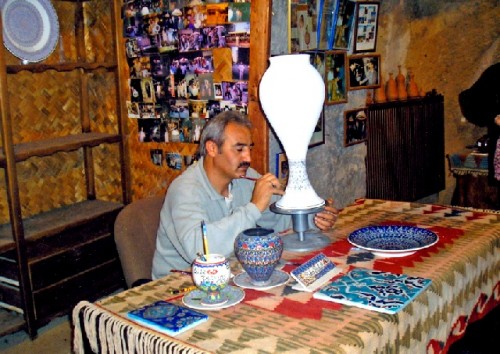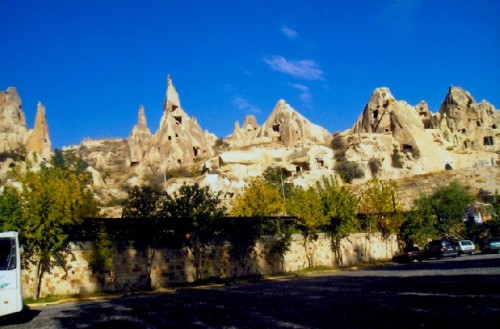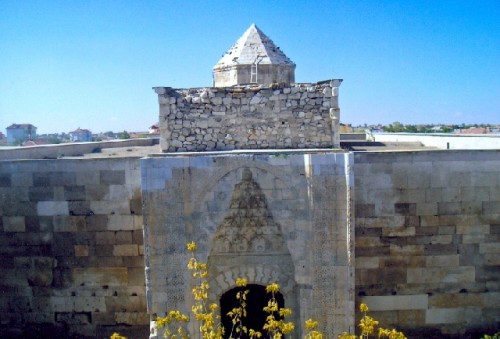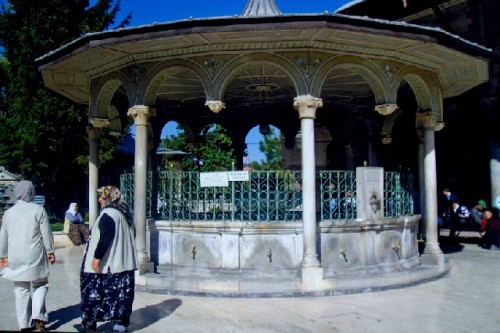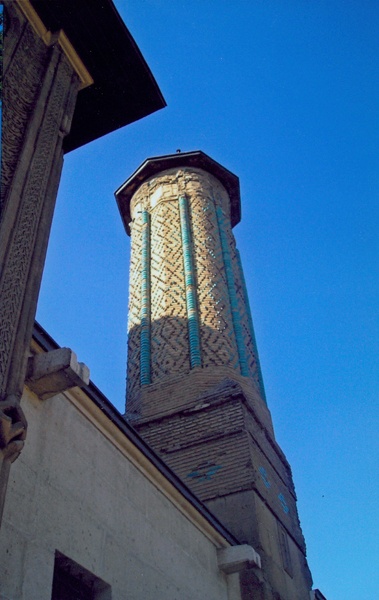Travels in Turkey Part 3
Cappadocia and Konya
By: Zeren Earls - Apr 10, 2007
Cappadocia
As we approached the Cappadocian Valley, the topography turned into a fantasyland. Volcanic tuff resulting from the eruptions of Mt. Erciyes overlies this region; the colors vary with different eruptions. The "giant sand dunes" exposed to the air have hardened and over time eroded into odd conical forms of gray-yellow rock, many more than 15 meters high. Called Peri Bacalari (Fairy Chimneys) in Turkish, some appear to have off-angle hats. After a quick walkabout we checked into the Perissia Hotel for two nights, leaving the discovery of this open-air museum to the next day.
The folkloric show in the evening introduced us to regional dances and music. To the accompaniment of davul (drum) and zurna (Turkish oboe), we watched the unveiling of a bride from the southeast (Antep), as the groom threw her a string of gold. Then we joined the wedding party and danced around the fire. The southern dance (from Silifke) featured wooden spoons, while the one from the northeast (Artvin) exhibited fast footwork. The dance from the east (Kars) with daggers showed off macho virtuosity. Violin, accordion and small drums played with the hands (darbuka) joined the big drum and oboe for most of the dances.
Kaymakh near Nevsehir is an underground city burrowed into the tuff. Used for refuge from invaders, many of the houses are used now for storing grains or as wine cellars. They have chimneys for ventilation and keep an even temperature throughout the year. In Orta Hisar we visited a cave house complete with living room, guest room and kitchen. Zelve is a village carved into the side of a mountain. Inhabited until 1950s, it has been declared unsafe by the government because of erosion. It is now a museum.
Lunch was at the Sömine (Fireplace) restaurant in Üsküp. Here we enjoyed the specialty of the house, Çömlek (earthenware pot) Kebap. The meat cooks slowly in a small earthenware jar, its mouth sealed tight with dough. The waiter breaks the pot with a single knife blow to the neck and pours the steaming contents onto a platter. Some of us took turns breaking the pots. I had to hit twice to break mine open.
Göreme is honeycombed with caves, which were once used for pagan worship. But most of them are rock-cut churches and monasteries decorated with historic narrative frescoes. My souvenirs from this area are a T-shirt depicting the emblematic cones of Cappadocia, known as the Three Graces, and lace work by local women.
Avanos is a charming town by Kizilirmak (Red River) famous for its pottery. The river's red soil provides the clay for most of the pots. A sculpture of stacked pots adorns the town square. The craft is passed on from generation to generation within families. We visited a shop, where a fourth generation potter gave us a tour of the premises. My favorite ones were urns and vessels inspired by ancient Hittite forms and designs.
In the Seljuk caravanserai of Sarihan we watched a Sema ceremony by the whirling dervishes. This ceremony symbolizes in seven parts the meanings of a mystic cycle to perfection. It is a journey of man's spiritual ascent. The dervish with his headdress (the tombstone of his ego) and white skirt (the shroud of his ego) is spiritually born to the truth by removing his black cloak, and advances to maturity through the stages of the Sema. While whirling his arms are open, his right hand directed to the sky, his left hand toward the earth; he turns from right to left revolving around the heart, thus embracing all of humankind. The accompanying drum sound symbolizes the divine order of the Creator and that of the bamboo reed (ney) the divine breath that gives life. After completion of the ritual, which ends with a prayer, the dervishes return silently to their cells for meditation. As we filed out in silence, I was glad to have gained insight into this unique ceremony inspired by Mevlana (1207-1273), who embraced all despite their differences.
On our way to Konya, Evin talked about education and military service. Education is compulsory for eight years and free to all through university. The Ministry of Education sets the curriculum, which requires foreign language instruction in all government schools. There are also vocational schools. Due to Turkey's large young population, every province has a university. However, entrance exams are tough and are heavily weighted toward math, natural and social sciences. To prepare for entrance exams, most students take private lessons outside of regular school hours.
Compulsory military service is two years. University graduates serve a shorter term of 20 months as officers. Recruitment takes place three times a year. Going to the army is a festive occasion in the villages; parents are proud to have their boys serve the nation. The first six months of their training includes instruction in family planning. 60% of the national budget goes to the army, which is the largest in Europe.
Traveling on the old Silk Road, we stopped at the Sultan Han Caravanserai. These inns with courtyards were built 20 miles apart, a day's trip on camel or horseback. Caravans carried silk, spices and salt from east to west, crisscrossing Anatolia via several land routes. The Silk Road lost prominence once sea routes were discovered. We climbed to the roof terrace of the Han and looked over grain fields and animal pastures. Villagers were harvesting pumpkin seeds, which are a major snack industry among many others. State-run until the 50s, all industry is now privatized, and dots the Anatolian landscape.
Konya
An old Roman town (Iconium), Konya is the grain capital of Turkey. It is also its religious center, with a population close to one million. Because of Ramadan all restaurants were closed during the lunch hour. The tall Hilton and the Mercedes dealerships attested to the current prosperity of its residents, all of whom observe a traditional dress code. A common sight is the solar-heated water depot on rooftops.
Konya's renown goes back to the 13th century as capital of the Seljuk Empire with its rich architecture: the Ince Minare (Thin Minaret) with its turquoise tile accents is now a museum of stone and woodcarvings; the Mevlana Museum is distinguished by its fluted turquoise tower and attracts people from all over to the Mausoleum of mystic, poet and philosopher Mevlana Celaleddin Rumi. His followers, the whirling dervishes, go through a nine-year training in the tekke here. Annually on December 14, they hold a festival to honor Mevlana's birthday. The Archeology Museum houses many finds dating back to the Neolithic, Hittite, Phoenician, Roman, Hellenic, Byzantium and Ottoman periods. Its most valuable piece is a sarcophagus decorated with reliefs of the labors of Hercules.
Before leaving town, Evin took us to a carpet shop at our request. Here we viewed beautiful naturally dyed woolen carpets and kilims. Carpets are knotted and heavier than kilims, which have a flat weave and are lighter in weight. I bought two of the latter, one with a stylized fly motif from Konya, and one, a runner, with a geometric pattern unique to Bergama. Muslims believe that Allah is the only creator of natural perfection; therefore the depiction of nature in decorative arts is always stylized.
The road to Antalya offered wonderful points of interest. We stopped in Beysehir to see the Esrefoglu Mosque built in 1297. Another Seljuk masterpiece with a capacity of 2000, the mosque's interior features carved and painted wood panels, in addition to mosaic tiles made of ceramic chips. In the center is a hole that collects water from the roof to provide moisture for its structural cedar posts and keep them from drying. The imam, who gave a tour of the mosque, recited a short segment from the Koran for us.
Crossing the Toros Mountain range (2400-2600 meters high), we came to the rest stop at Zirve (the Peak), where we enjoyed lunch with a panoramic view. The rocky side of the mountain gave way to lush green land below with cedar, cypress, oak and poplar trees. The souvenir shop carried local honey from the high plateau, as well as pottery and onyx ware from nearby towns. My lucky find here was a translucent onyx bowl at a very modest price. Often these items command high prices in big city markets.
Heading south to the Mediterranean flatland, we passed by olive and palm trees; vendors sold bananas and citrus fruit by the roadside. Heaps of dry sesame plants awaited a beating to let go of their seeds. We passed by the Manavgat River and a 2nd-century AD aqueduct amidst wild blackberries and cotton fields, arriving at Aspendos, the world's best-preserved Roman theater. I climbed to the highest of the forty rows surrounded by a vaulted gallery, and sat down as an attendee in this 15,000-seat theater. Quickly drawn to the time of Emperor Marcus Aurelius (161-180 AD), I looked down upon the stage, imagining the actors in this setting with perfect acoustics. There was the statue of Dionysus, patron god of theaters, at the base. However, it was disconcerting to see the metal scaffolding with myriads of lights angled to the stage for the amplified pop concerts that are now held here for twice the number of people – a thoughtless contribution to the deterioration of antiquities.
Following the coastal road to Antalya, we passed by hothouses, tented markets, houses with flat rooftops and satellite dishes on balconies. Hotels, holiday villages, car dealers and jewelry shops beckoned both local and international tourists. Ready for a taste of the Turkish Riviera, we pulled up at the Khan Hotel, where we spent three nights.

